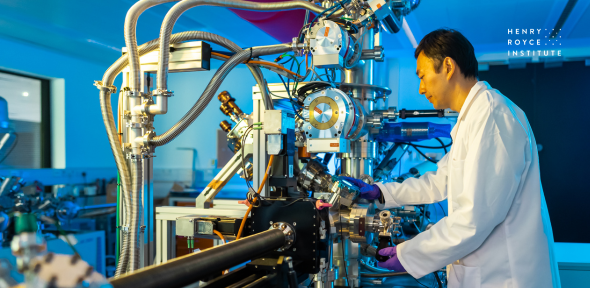
X-ray Photoelectron Spectroscopy (XPS)
X-ray Photoelectron Spectroscopy (XPS) is the most widely used surface analysis technique. It can be applied to a broad range of materials and provides valuable quantitative and chemical state information from the surface of material being studied. It is significant for many industrial and research applications where surface or thin film composition plays a critical role in performance. Recent advancements in spectrometer design, the introduction of argon cluster sources for controlled erosion of organics and inorganics, near ambient pressure gas environmental control, and temperature control etc. have increased the application of XPS to a more extensive application range.
Near Ambient Pressure Environmental (NAP-XPS)
The near ambient pressure (NAP) X-ray photoemission spectroscopy (XPS) system is for high-throughput chemical surface analysis under application relevant environmental conditions.
The system overcomes barriers of traditional XPS systems by enabling analyses at a wide range of atmospheres ranging from 10-7 mbar up to 100 mbar. Via three separate, mass-flow controlled gas inlets, the system allows to create a wide range of reactive environments and hence to directly probe energy materials and devices under application relevant conditions. Via a sample holder with built-in laser heating, the tool allows direct probing of samples at temperatures up to 1000C in these atmospheres, enabling for instance new insights into material growth and discovery in particular for nanomaterials relevant to EE ICT.
There is a built-in plasma cleaning and specific holder design to minimise cross-contamination and a horizontal sample loading. Sample loading is also possible without going through high vacuum, so a wide range of materials can be probed including liquids, biological materials, ceramics, polymers and materials with high vapour pressures.
The system uses a SPECS XR 50 MF X-ray Source, μ-FOCUS 600 X-ray monochromator and differentially pumped PHOIBOS 150 1D-DLD NAP analyser. The system also has scannable focused extractor type ion source for depth profiling. The system will be run as an XPS facility together with existing standard UHV-based XPS/UPS system.
If your research interests require controlled deposition of any of the above materials or you would like to combine functional materials in novel ways and have any questions on the tool’s capabilities please contact Facility Manager Dr Shaoliang Guan (sg2156@cam.ac.uk) or via the Collaborative R&D Environment (CORDE) at the Department of Physics.
Escalab 250Xi ultra High Vacuum Photoemission UPS/ XPS
An ultrahigh-vacuum photoemission instrument, an Escalab 250Xi, will be run alongside the near ambient pressure (NAP) X-ray photoemission spectroscopy (XPS) system as a combined joint facility.
The current instrument has the following complementary capabilities:
• X-ray photoemission spectroscopy (XPS) for chemical analysis of surfaces under inert, UHV conditions
• Ultra-violet photoemission spectroscopy (UPS) for measurements of valence bands and work functions with a 21.2eV excitation source
• Angle resolved x-ray photoemission spectroscopy (ARXPS) by varying the angle that the sample is held at and in this way varying the analysis depth down to a few nanometers. This is a non-destructive technique.
• Depth profiling x-ray photoemission spectroscopy (DPXPS) which combines a sequence of argon ion gun etch cycles with XPS analysis. This is a destructive technique.
If your research interests require access to this XPS system and have any questions on the tool’s capabilities please contact Facility Manager Dr Shaoliang Guan (sg2156@cam.ac.uk) or via the Collaborative R&D Environment (CORDE) at the Department of Physics.
Nexsa G2
The Thermo Scientific Nexsa G2 Surface Analysis System is a high-performance X-ray photoelectron spectrometer with fast sample loading. It is compatible with powders and solid samples. The sample size is limited to 6x6 cm2. Please discuss with the facility scientist if the samples are thicker than 1 cm.
Key Capabilities:
- Monochromated Al K-α X-ray source with microfocused beam, adjustable from 10-400 μm
- EX06 monatomic ion source with ion energy range from 200 eV – 4 keV
- Dual beam flood gun provides reliable charge compensation
- Load-lock with fast pumping and automated transfer
- Three camera viewing system to easily find features to analyse
- NX Heather for software-controlled sample heating
- XPS SnapMap and sample imaging
If your research interests require access to this XPS system and have any questions on the tool’s capabilities please contact Facility Manager Dr Shaoliang Guan (sg2156@cam.ac.uk) or via the Collaborative R&D Environment (CORDE) at the Department of Physics.
